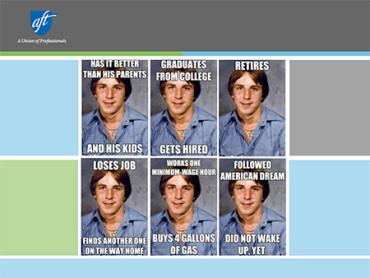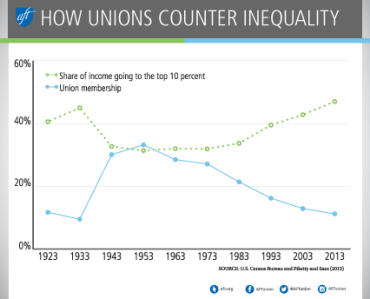Collective bargaining: Wage grower, quality enhancer
Remarks by AFT President Randi Weingarten
Philip Murray Labor Lecture at Penn State University
April 15, 2015
This is Old Economy Steve. You may have seen him pop up on your Facebook or Twitter feed. Or maybe he sits at your Thanksgiving dinner table, only you call him Uncle Bob, Cousin Jim or even Dad.
When Steve was getting his start, American capitalism was dominated by mass industries like auto and steel. Good jobs—and I’d add, good union jobs—were easier to come by. The entire cost of college tuition was roughly what you’d pay for one credit hour today. And retirement security wasn’t an oxymoron. The American dream—the idea that if you work hard and play by the rules, you can get ahead—was within Steve’s reach.
Unions built the middle class
So, why did Steve do okay? Well, there are a few reasons—including the GI Bill, a growing economy, progressive public education and labor legislation, and, of course, unions. When unions were at their peak, more workers—upward of 50 percent—were in the middle class. Even those who were historically marginalized and disenfranchised—women and African-Americans and Latinos—had a clearer path to the middle class. Private sector unions helped drive up all workers’ wages, and public sector unions ensured better government services for the poor and middle class. And the gap in income between the wealthy few and the rest of us was about half of what we see today.
As Hillary Clinton—whose dad and brother were proud Nittany Lions—put it, “The American middle class was built, in part, by the right for people to organize and bargain.” And I’d add, “The American middle class can be rebuilt by the right for people to organize and bargain.”
Our economy, then and now
Our economy is different from the “old economy,” Steve’s economy. Then, 1 in 3 workers was a union member. Now, 1 in 3 workers is a freelancer. Then, you didn’t need a college education to get a middle-class job. Now, college grads earn about $1.2 million more than someone with a high school diploma. Then, only 11 percent of women were the leading or solo breadwinners in their households. Now, more than 40 percent of women hold that mantle. Then, the global economy was focused on industry. Now, we are in the technology era, with knowledge moving at the speed of light.
Collective bargaining as a wage grower
Then and now, collective bargaining can lift all boats, even those boats that aren’t carrying a union card.
This is what I mean. Today, productivity has increased, but only the wealthiest 10 percent have shared in the gains. Economists have estimated that declining unionization accounts for about a third of the increase in inequality.
Conversely, when unions were at their height, productivity and all workers’ wages rose at the same rate—doubling through the 1970s. As a result, for a time, there was shared prosperity. That’s how collective bargaining has a multiplier effect.
Let’s take this step-by-step: Collective bargaining raises wages for union workers. That pressure helps other workers in the community get raises. That creates more buying power for consumers and greater spending in local economies, which is important because two-thirds of our economic activity is driven by consumer spending. That raises the standard of living, spurring on more tax revenue (happy Tax Day, by the way). That helps more money get to our schools, which can create more opportunities for kids. And on and on and on.
Look at wages. In the heyday of the American labor movement, nonmanagerial workers’ wages went up by as much as 75 percent. As unions have been on the decline, these workers have only seen a 4 percent bump. Still, even today, union workers earn 28 percent more than nonunion workers. Women in unions earn 31 percent more. And unionized women of color earn 35 percent more.
This also happens with retirement security. I know the last thing on your mind right now is retirement—although maybe not. A study out this year found that three-quarters of millennials expect to work well past retirement age. Eighty-six percent of Americans believe our nation faces a retirement security crisis, which is not surprising considering middle-class workers have an average of $20,000 saved for retirement. That’s not $20,000 every year, that’s $20,000. Unions bargain a secure retirement on behalf of workers, often in the form of pensions. Pensions ensure that workers can retire with financial dignity and they are important investors in our economy. For every dollar paid in pension benefits, there’s $2.37 in economic output.
Collective bargaining—when workers have access to it and have the power to exercise it—is one part of a virtuous cycle, a cycle that begins with a high-quality public education that gives students the skills they need to get good jobs with fair wages, helping each generation climb the ladder of opportunity. This virtuous cycle is essential to bolstering our economy.
Collective bargaining as a quality enhancer
Your generation, the millennial generation, has been poked and prodded by researchers of all stripes. A quick Google search pulls up thousands of studies, uncovering everything from how many tattoos you have to how much you are likely to give to charitable organizations.
We also know a lot about what millennials want at work. You want flexibility. You want community and a collaborative work environment. You want to be supported and appreciated and fairly compensated. You want opportunities for advancement and professional development. (Be sure to ask me about Share My Lesson in the Q&A. It always shocks people that the AFT has the fastest-growing ed-tech company in the country. It’s all about professional development.)
Millennials want a real voice on the job. If you’re a nurse, you want a say in decisions regarding your patients’ care. If you’re a teacher, you want a say in decisions regarding your students’ education. If you’re a steelworker or an autoworker or a coder, you want a say in decisions regarding how your products are created. Collective bargaining can give you all of that. And where it has, it’s been a win for workers and a win for management.
And I’m talking real, sustainable wins, better than the regulations—like paid sick leave—that we’re fighting for now as a substitute for collective bargaining. With collective bargaining, unfair actions can be challenged in arbitration rather than court. With collective bargaining, checks and balances are tailored to the workplace. It’s not a one-size-fits-all regulation. It’s more efficient and effective.
We all want to see greater efficiency in government, greater effectiveness in corporations and greater productivity across the board. We know that when workers are satisfied and supported, they work harder. One study found that happy workers are 12 percent more productive. And we know that when labor and management work together, there are better outcomes for everyone.
Let me give you an example from my own union, where collaboration with management has improved student achievement. In the ABC Unified School District outside of Los Angeles, a partnership between the district and the ABC Federation of Teachers was forged in the late 1990s, when district administrators, school board members and union officials came together to figure out ways to improve education. As a result, ABC Unified’s district score on California’s Academic Performance Index has increased every year under the labor-management partnership, most recently coming in 53 points higher than the state average.
In a study about workplace practices and productivity in the private sector, Sandra Black and Lisa Lynch wrote, “[U]nionized establishments … that promote joint decision making … have higher productivity than other similar nonunion plants.” They also found that high-performance workplace practices alone can’t enhance productivity. “[I]ncreased employee voice … seems to be a necessary condition to making the practices effective.”
Workers need a voice. And through collective bargaining, workers get the voice they need, a collective voice. Individual voices may be drowned out, but when we join our voices together, when we take action together, we are heard. It’s no wonder that union members have been found to have higher life satisfaction, or as the New York Times put it, “Want to be happy? Join a union.”
Bargaining for the common good
For collective bargaining to work in the 21st century, it can’t be based on a 20th-century model. Think about it. Rarely do we have one industry that dominates the economy of a community or workers who stay in one place their whole career. We can no longer focus exclusively on the workplace or rely on union density to set market standards, raise wages or improve working conditions.
So, as our economy changes, as work changes, how we bargain and what gets bargained must also change. As unions have diminished in size, how we think about density must change as well. Community is our new density. And we need a new approach that builds power through partnership with community and leverages that power at the bargaining table to advance community needs. Some call this bargaining for the common good—that is, bargaining that addresses both the needs of the company and/or the needs of the community.
We did this a few years back in New York. There were a few dozen schools in the city that were struggling. The union worked with the district to put in place research-based strategies to raise achievement: class size reductions, a longer school day for tutoring and small-group remediation, a common curriculum aligned with high standards, common teacher planning time, and a school site labor-management collaborative governance structure. Students in these schools made rapid gains, far outpacing citywide gains in reading and math.
And then, a few years later in the South Bronx, we saw the same kind of results. District 9 was, by all accounts, failing. The union wanted to help. The community clamored for change. So, we partnered with CC9, the Community Collaborative to Improve District 9 Schools. Together, we focused on teacher quality, school leadership and family-school partnerships. We established the lead teacher program, which let seasoned teachers mentor newer and struggling teachers. CC9 members even helped hire the lead teachers. The district had the largest gains in student achievement in the city, and the lead teacher program was then negotiated citywide.
New York isn’t alone. I was in Pittsburgh this morning, talking to parents and community leaders from Woolslair Elementary School, where the union joined with the community to turn around that struggling school. We’ve seen the same thing at the Oliver Partnership School in Massachusetts and Reagan Early College High School in Texas. Both schools could have closed, if it weren’t for the union and community working with management to fix them.
Building on our new contract in San Francisco, the union is partnering with the city and school district there to ensure that teachers can live near neighborhood public schools and spend more time in classrooms. The median home price in the city is more than $1 million, and monthly rental prices top $3,200.
Our healthcare affiliate in New Jersey is using evidenced-based research on nurse staffing in efforts to align policy at both the bargaining table and in our legislative advocacy—all to improve patient care outcomes and to advance the profession of nursing.
Bargaining for the common good gives everyone a seat at the table—workers and consumers, workers and those they serve, workers and the broader community. It’s expanding the definition of collective bargaining to, as my friend Sarita Gupta at Jobs With Justice has said, “tilt the balance of power in favor of workers taking collective action.”
This is especially important in the private sector. There, collective bargaining used to mean negotiations between workers and their immediate employer. But think about the McDonald’s cook who thinks his immediate employer is the franchise manager when, really, the negotiating power is held at corporate headquarters. It’s a shell game. And one where workers will lose, unless we expand who is at the bargaining table and what we’re bargaining for. If we do that, we can again provide the checks and balances to corporate power that we did when labor was at its strongest. That’s what activists are working to do today in the Fight for $15 campaign, and that’s what Sen. Elizabeth Warren means when she often says, “If you aren’t at the table, you’re on the menu.”
The attacks on labor
But there are those who don’t want corporate power to be checked. They don’t want a balance. They want workers to be squeezed. And they’re perfectly happy with the status quo.
The hypocrisy is stunning. Take Scott Walker, whose attacks on labor have been relentless and egregious during his tenure as governor of Wisconsin. On the campaign trail this time, Walker said he’d do everything in his power to stop a so-called right-to-work bill—a misnomer if I’ve ever heard one—that would strip workers of their right to organize and bargain collectively. But when he decided to run for president, he kicked that commitment to the curb. And last month, he signed into law the very bill he promised not to.
Workers in “right-to-work” states make about $1,500 less per year. This wage loss also causes workers leave the state, depressing job creation, and there’s a sizable economic loss to the state.
Walker’s decisions for Wisconsin have been detrimental, and we need only to look one state west to see how much. Minnesota Gov. Mark Dayton has boosted the minimum wage, invested in public education and supported workers’ rights. As a result, he has turned his state’s budget deficit into a projected surplus of nearly $2 billion. Today, Minnesota’s unemployment rate is 3.6 percent—far below the nationwide rate of 5.7 percent. Meanwhile, Walker has swollen his state’s budget deficit to a projected $2 billion. Wisconsin’s job growth has been among the worst in the region, and its income growth has been among the worst in the nation.
There’s a moral to this story: If you want a strong middle class, then you can’t take out the unions that built it. If you want good jobs with higher wages, then workers need a voice.
New Economy Steve
We need a new meme. We need New Economy Steve—and Stephanie, and Maria, and Evan, and Sarah, and Molly.
They face different challenges than Old Economy Steve: rising student debt, stagnant wages, growing income inequality. Still, like you, they want the future to be bright, and they hold that enduring American value—that each generation can do a little better than the one that came before it. They’re a part of the growing movement of workers and community members who are demanding a raise, who are fighting for the right to bargain and organize.
As you enter the workforce, remember: Power never yields willingly, but it cedes to the power of working people joining together and speaking out. Our economy grows with increased efficiency, but that growth is shared only through increased voice and increased action. Shared prosperity is within your reach. You just have to join together, speak out together, act together, bargain together.
Thank you.



